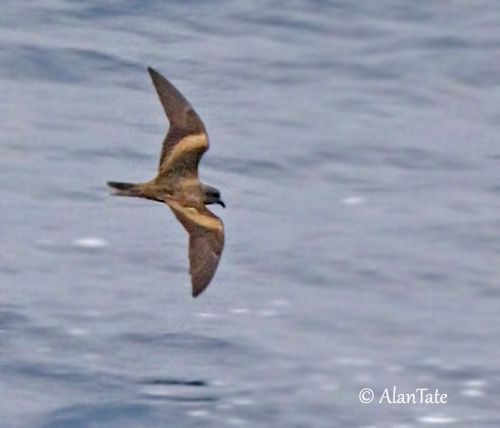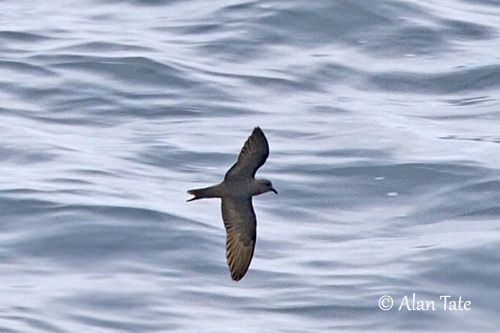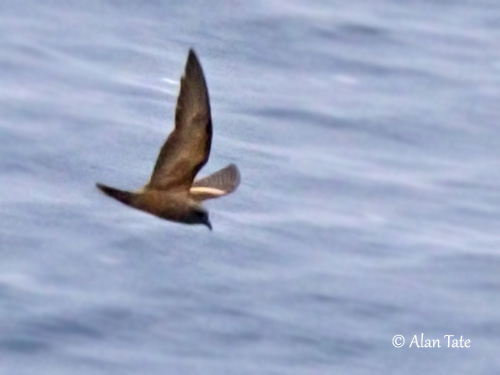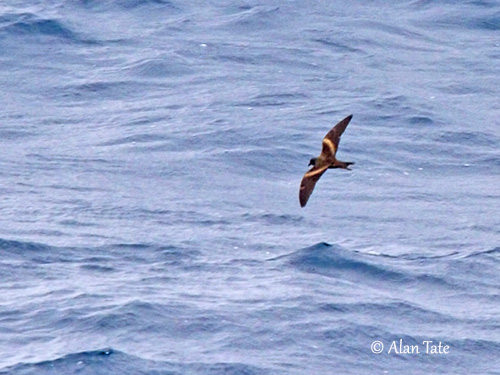
The colonies are found in saltpetre deposits, on slopes, within 25 km from the sea. The nests are built into holes, cavities or crevices in the ground without addition of material. The cavities are formed by the salt, with an entrance of 9-10 cm in diameter, usually between 6 and 18 centimetres.
The female lays a single white egg per season. The incubation lasts around 47 days (in Paracas), shared by the adults with shifts of three days or less. During this period, the adults communicate by vocalizations, one bird at nest entrance and the other deep in the burrow.
After hatching, the young bird is fed by both parents. It leaves the nest and moves towards the sea.
The fledglings are often attracted, disoriented and grounded by artificial lights, and numerous juvenile are lost.
PROTECTION / THREATS / STATUS:
The Markham's Storm-Petrel is threatened by the mining of saltpetre in the salt plains where the colonies are established, involving the loss of numerous breeding areas caused by destruction of burrows and crevices used for nesting.
The light pollution represents a large level of mortality when placed close to the colonies. Around 20,000 fledglings die each year due to light pollution. However, the grounded fledglings are rescued and released by the Service Agricola y Ganadero.
Human developments such as wind farms and power lines are also a significant threat for the birds.
The size of the population is roughly estimated to number 50,000/60,000 breeding pairs, equating to 150,000/180,000 individuals.
The species breeds only in a small number of relatively small colonies which are threatened by degradation of the habitat, and the population is suspected to be declining.
The Markham's Storm-Petrel is currently classified as Near Threatened.
Fr: Océanite de Markham
Ang: Markham's Storm-Petrel
All: Rußwellenläufer
Esp: Paíño Ahumado
Ita: Uccello delle tempeste di Markham
Nd: Humboldts Stormvogeltje
Sd: sotstormsvala
Photographers:
Alan & Ann Tate
AA Bird Photography
Text by Nicole Bouglouan
Sources:
HANDBOOK OF THE BIRDS OF THE WORLD vol 1 by Josep del Hoyo-Andrew Elliot-Jordi Sargatal - Lynx Edicions - ISBN: 8487334105
Petrels, Albatrosses, and Storm-Petrels of North America: A Photographic Guide De Steve N. G. Howell – Editor: Princeton University Press, 2012 – ISBN: 0691142114, 9780691142111 – 482pages
OISEAUX DE MER – Guide d’identification de Peter Harrison – Editions Broquet (Canada) – ISBN-10 : 2890004090 – ISBN-13 : 978-2890004092
BIRDS OF PERU by Thomas S. Schulenberg, Douglas F. Stotz, Daniel F. Lane, John P. O’Neill, Theodore A. Parker III – Princeton University Press 2007– ISBN: 978-0-691-13023-1
THE DIET OF MARKHAM’S STORM PETREL OCEANODROMA MARKHAMI ON THE CENTRAL COAST OF PERU
Breeding of Markham’s Storm-Petrel (Oceanodroma markhami, Aves: Hydrobatidae) in the desert of northern Chile
Markham's Storm Petrel breeding colonies discovered in Chile
Breeding phenology, distribution and conservation status of Markham’s Storm-Petrel Oceanodroma markhami in the Atacama Desert
Living on the edge: genetic structure and geographic distribution in the threatened Markham's Storm-Petrel (Hydrobates markhami)
Wikipedia, the free encyclopaedia
Markham’s Storm Petrel
Hydrobates markhami
Procellariiformes Order – Hydrobatidae Family
INTRODUCTION:
The Markham's Storm-Petrel is found in the Pacific Ocean, around Ecuador, Peru and Chile, with observations W of Galapagos Islands, within the Panama Bight, and off Baja California. It is classified as endemic of the Humboldt Current, off South America. This species breeds only in Peru and Chile.
The Markham's Storm-Petrel spends most of its life at sea, and comes to the shore only for nesting underground in natural crevices and holes or burrows. Both parents share the nesting duties.
Like other storm-petrels, it feeds on the wing and by picking prey from the water surface. It feeds on fish, squid, shrimp and krill, depending on weather and season.
The name of the Markham's Storm-Petrel pays tribute to Captain Albert Hastings Markham, who collected the first specimen off Peru. He was an English geographer and traveller.
The Markham's Storm-Petrel is threatened by light pollution, destruction of breeding colonies caused by human activities, and commercial fishing reducing the food resources.
The species is currently classified as Near Threatened.

DESCRIPTION OF THE BIRD:
Biometrics:
Length: 21-24 cm
Wingspan: 53 cm
Weight: 53 g
The Markham's Storm-Petrel has sooty-black upperparts, becoming blackish-brown on the underparts.
On the upperwing, greater wing-coverts and scapulars are paler, mainly grey-brown. We can see a conspicuous diagonal bar across the open wing. This pale bar reaches up to the carpal area where it is broader.
In worn plumage, this bar becomes paler, whereas in fresh plumage, head, neck and mantle show a plumbeous gloss.
The tail is long and notched. On the uppertail, the distal coverts are sometimes paler than the back, involving a contrast with the blackish tail.
On the blackish-brown underparts, the underwing is blackish-grey with faint silvery sheen. The flight feathers are darker, almost black, but the bases of the primaries may be white.
The bill is black. The eyes are brown. Legs and feet are black.
Male and female are similar.
Adult and juvenile don’t show morphological differences.
RANGE:
The Markham's Storm-Petrel is classified as endemic to the Humboldt Current, a cold, low-salinity ocean current flowing N from Antarctica along the W coast of South America.
This species breeds in the Paracas Peninsula (Peru), also in Arica, in Atacama Desert (N Chile), and probably in S Peru near Pica.
The Atacama Desert is one of the driest places in the world. The Markham's Storm-Petrel nests in natural cavities and crevices, in parts where deposits of salt make good nesting areas for this species. In addition, mammals and other predators are absent, making the birds safe in this area.
Outside of breeding season, the Markham's Storm-Petrel frequents the cool waters of the Humboldt Current off Peru and N Chile. But observations farther off Mexico and off Chile have been reported.
During the austral autumn, great densities of birds are found offshore between Guayaquil and Lima.

HABITAT:
The Markham's Storm-Petrel breeds on coastal islands. It nests in holes and crevices in saltpetre deposits, up to 25 km from the coast.
The colonies are established in flat areas with small hills offering some saltpetre deposits. The temperature is around 40°C in the desert, but it is usually between 28 and 30°C inside the cavity.
During the non-breeding season, the birds remain at sea in the cold waters of the Humboldt Current. The densities increase with the salinity.
CALLS AND SONGS: SOUNDS BY XENO-CANTO
The Markham's Storm-Petrel can be heard between April and August, with a peak in June.
The sounds are described as series of wheezes, purrs and chatters. The birds call in flight, but also from within the nest cavity.
BEHAVIOUR IN THE WILD:
The Markham's Storm-Petrel feeds mainly on fish, cephalopods and crustaceans. The main prey are (among others) the Peruvian Anchovy (Engraulis ringens), the Pelagic Squat Lobster (Pleuroncodes monodon) and the Oceanic octopus Japetella.
The fish is fed both inshore and offshore, whereas cephalopods suggest only offshore feeding. From observations and studies through several years, it is suggested that the Markham's Storm-Petrel forages opportunistically on available food occurring near the sea surface.
The diet of the Markham's Storm-Petrel varies among years, especially during El Niño and La Niña events involving changes in water temperature and food availability.
The bird feeds by swooping down to the water surface and pattering the feet on the water. The wings are raised in a V as the bird catches the prey with the bill. It may also pick at food item when on the water, while the wings are raised and fluttering.

The Markham's Storm-Petrel is probably socially monogamous like all storm-petrel species. It nests in colonies in highly variable densities. The nest is underground, in natural crevices, holes, cavities or burrows.
When at sea, it can be seen solitary or in small groups, sometimes associated with other storm-petrel species.
The movements of the Markham's Storm-Petrel are poorly known. During the non-breeding season, it apparently moves northwards to reach tropical waters, and the sub adults are moving farther than the adults.
During the breeding period, the birds come to the colonies at night to avoid predation, flying through canyons in the Atacama Desert, between the sea and the colonies.
The Markham's Storm-Petrel flies with deep wingbeats interspersed with long glides. The flight is described as fairly low while the wings are held slightly arched.
While foraging at sea, it flies into the wind with steady wingbeats, some pauses and short glides. When a prey is located, it swoops down to the food item and patters briefly, while the wings are raised in a V.
REPRODUCTION OF THIS SPECIES:
The breeding season may vary within a colony, depending of different populations. In the colonies of Paracas, Arica and Salar de Quiña, the period extends from April to August, with the egg-laying in April until August, depending on the pairs. The chick-rearing period takes place between July and January, with the young leaving the nest between October and February.
However, in the colonies of Caleta Buena, Salar Grande and Salar de Navidad (140-240 km S of Arica colony), this period starts between November and January, with the egg-laying from November through February. The chick-rearing is between January and April, and the young leave the nest between March and June.
The gap between periods is not clear and more information is required.
